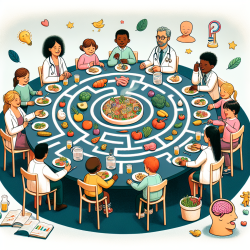Introduction
As a practitioner focused on improving outcomes for children, it's crucial to integrate findings from diverse research areas into your practice. The study titled "Thrifty-Eating Behavior Phenotype at the Food Court – Programming Goes Beyond Food Preferences" offers valuable insights that can be applied to enhance therapeutic interventions, particularly in understanding the underlying neuropsychological mechanisms affecting children's decision-making and behavior.
Understanding Thrifty-Eating Behavior
The study investigates the impact of being born small for gestational age (SGA) on feeding behavior and brain connectivity. It highlights how prenatal growth impairments can influence food preferences and decision-making, potentially leading to long-term health risks. SGA individuals often show altered functional connectivity in brain regions associated with reward and self-control, such as the orbitofrontal cortex (OFC) and dorsolateral prefrontal cortex (DL-PFC).
Key Findings
- SGA adolescents spent less money on snacks but consumed similar calories, suggesting a preference for cheaper, possibly less nutritious foods.
- Altered brain connectivity in SGA individuals was observed, affecting areas related to reward and decision-making.
- Differences in connectivity patterns between children and adolescents suggest developmental changes in cognitive networks.
Implications for Practitioners
These findings underscore the importance of considering neuropsychological and developmental factors in therapeutic settings. Practitioners can use this information to tailor interventions that address specific behavioral and cognitive challenges faced by SGA individuals. By understanding the altered connectivity patterns, therapists can design strategies that enhance decision-making skills and promote healthier food choices.
Encouraging Further Research
While this study provides a foundation, further research is needed to explore the long-term implications of altered connectivity and behavior in SGA individuals. Practitioners are encouraged to contribute to this research by observing and documenting the outcomes of tailored interventions, thus enriching the data pool and enhancing the understanding of these complex relationships.
Conclusion
Integrating insights from the "Thrifty-Eating Behavior Phenotype at the Food Court" study into therapeutic practices can significantly improve outcomes for children. By focusing on the neuropsychological underpinnings of behavior, practitioners can better support SGA individuals in making healthier choices and achieving better developmental outcomes.
To read the original research paper, please follow this link: Thrifty-Eating Behavior Phenotype at the Food Court – Programming Goes Beyond Food Preferences.










